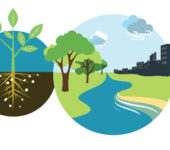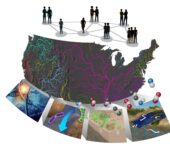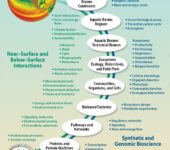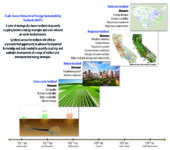Scales
-

Biological and Environmental Research
BER research seeks to understand the fundamental biological, biogeochemical, and physical principles needed to predict a continuum of processes occurring across scales, from molecules and genomes at the smallest scales to environmental and Earth system change at the largest scales.
-

Integrated Watershed Science Scale and Network
Watersheds and their associated basins organize terrestrial landscapes (map of continental United States with different colors indicating different basins) and integrate physical, chemical, and biological processes across scales (lower boxes showing molecular to river corridor scales). The vision of open watershed science by design is for the community to pursue integrated watershed science as a collective network (indicated by connected people in the graphic) that does together what would be impossible to do alone.
-

Scales of BER and ESS Research
Molecular Science Challenges in Biological and Environmental Research. The Department of Energy’s (DOE) Biological and Environmental Research program (BER) supports research that spans an enormous breadth of spatial and temporal scales in the biological, climate, and environmental sciences. Fundamental molecular process research underpins an understanding of larger-scale phenomena of interest to BER and DOE.
-

Proposed Network of Energy Sustainability Testbeds Scales
These testbeds comprise a suite of strategically distributed study sites chosen to span a range of scales, each relevant to a particular energy strategy and associated air-water-land forcing. Each testbed could be used for experiments, observations, and modeling to address a unique set of questions. Synthesis across the testbeds could offer an unprecedented opportunity for advancing the fundamental knowledge and tools needed to develop a range of resilient and interconnected energy strategies.